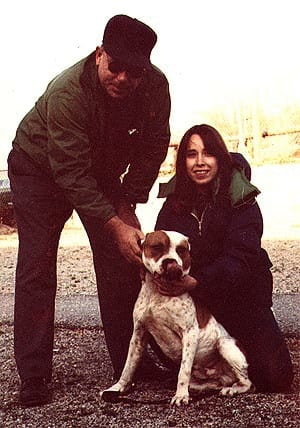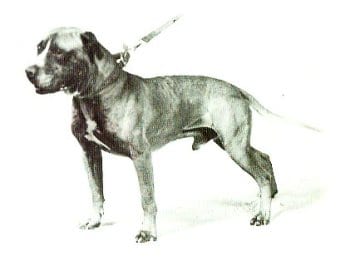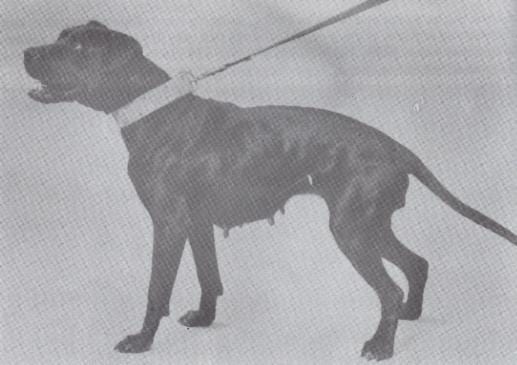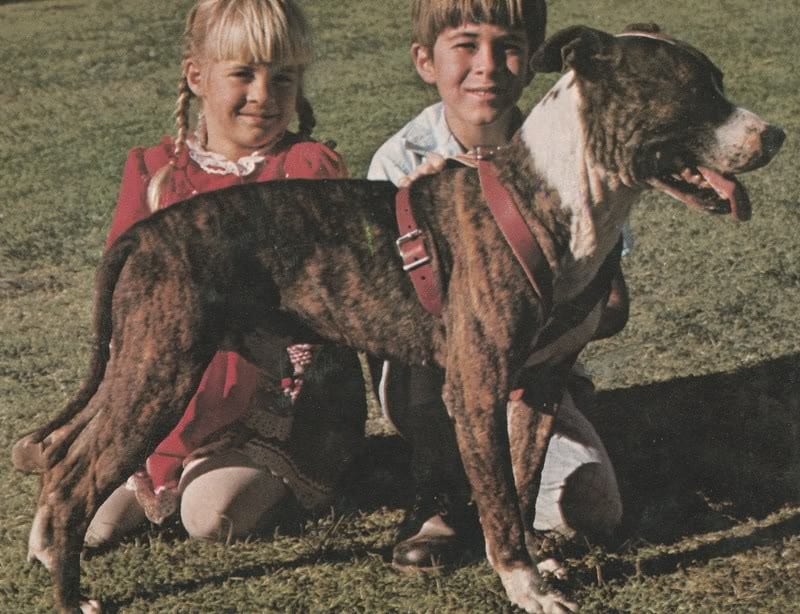Search Posts
Recent Posts
- The Long Goodbye January 18, 2024
- Once More Around the Mulberry Bush January 9, 2024
- The Wash December 28, 2023
- The Truth About Carver Dogs December 1, 2021
- The Question of Pain November 9, 2021
Categories
Subscribe!
Thanks for subscribing! Please check your email for further instructions.
Bad Moves
by
Richard F. Stratton
A long time ago in a Galaxy far away, I was part of a group to select the best dog and the gamest dog in a convention. Okay, it wasn’t really a long time ago or in a different galaxy, but I am in favor of keeping it quiet about good dogs in other countries, even where it may be legal. I suggest that all dog men consider anything they write to be read by humaniacs. For such people, as well intentioned as they may be, have plenty of time on their hands to try to change laws in even other countries. I could say a lot about that, but I’ll save it for another time. For now, I want to talk about bad moves and bad signs.
I’m reminded of such things because this was a particularly good convention with outstanding dogs. There were six matches, and after the very first one, I thought we had our best dog and gamest dog, as the losing dog was picked up by his handler, but he made a very game scratch. But there was much more to come. The next match featured two very good dogs, a red male and a black one. I generally prefer red dogs, but I don’t care what color good ones are. After all, one of the best I ever saw was Grand Champion Hope, a very good black daughter of the immortal Tombstone. In any case, the red dog seemed to be getting the best of it, as he was quite a talented individual. In fact, he kept such pressure on his opponent that he actually stood him up and pushed him clear out of the pit. That reminded me of the famous boxing match in which Jack Dempsey was knocked out of the ring by the Argentinean Luis Alan Firpo, but he came back in to win the fight. There was a similar ending in this dog contest. The black dog came from behind to win, amazingly. They were just two marvelous dogs.
When it came time to pick the best dog, we had already seen six matches and many good dogs. The last match consisted of females, a little red bitch and a buckskin one. The buckskin barnstormed the red one for the majority of the match, but the red one hung in there, and she continued to do everything right. She stayed out of trouble as much as she could, considering the stomping she was getting. Then, the tide began to turn. The longer that match went, the more enthusiastic she became. To me, that has always been the sign of a game dog—that they maintain enthusiasm as fatigue begins to set in. She eventually won, as the buckskin gyp took the count. For me, that was our game dog. I was somewhat conflicted, as the red male in that classic second match had made an amazingly game courtesy scratch. The tide had turned against him when his opponent was able to get into his stifle and do enough damage that his owner picked him up and conceded that match. Another strong test for gameness is when the tide changes for a dog that is dominating the match, so the fact that he made his straight and true scratch was all the more impressive. Still, I thought the little red female was our best candidate for Gamest in Show.
We had three judges. One of the three was a man I didn’t know, but he was adamant that the red male should get the gamest trophy. I made the point that the red female had more obviously won on gameness. The other judge replied that she had made some “bad moves.†Since it was something of a tossup for me, I acquiesced for the red male. However, I thought I would talk a little bit about “bad moves.â€
First of all, what are they? One thing has always amused me is that when a dog man recounts a fight in which he had to pick up his dog, the other dog always looked like he was going to quit! That’s the way they always seem to remember it. Well, you picked your dog up, presumably to save his life, so your dog was probably not looking too good either. But what are these mysterious signs that such people see? When I’ve been present, all I ever saw was a tired dog, but not one that had lost interest.
Turns
The most obvious bad move is a turn. I think that’s what the judge had in mind when he argued against the red gyp, although I don’t think anyone ever asked for a turn. To me, she just seemed to be trying to maneuver out of a hold, but no matter.
You can imagine, many hundreds of years ago, when people first started doing this, that there had to be a way of determining a winner. I suspect most people agreed that a dog that was no longer interested in the fight was the loser. Obviously, a dead dog would be a loser, too, but if they are matched to weight, that isn’t going to happen very often. So that’s how scratches probably started: to prove that a dog still was interested in the fight. But when do you start the scratching? Someone must have come up with a definition of a turn as being one reason to start the scratching. Later on, out-of-holds counts were added, and that wasn’t all that long ago, as I can remember conventions down at Leo Kinard’s place, many decades ago, in which the dogs were just lying in the pit, not even touching each other. Bob Hemphill was one fellow who decided a change of rules was needed. Not only was it boring to watch the dogs lying there, but the longer the dogs were kept from medical attention, the less likely they were to survive.
So a turn is most definitely a bad sign, but it isn’t a hundred percent reliable. There have been great dogs in the past that would make terrible looking turns—and one of them was Grand Champion Hank! I think the reason he was able to get so many matches was that everyone thought he looked like he was going to quit. In this case, there was more justification in thinking so. Nevertheless, they were never able to stop him—no matter how good the dog they brought or the turns that he made!
I remember others, too. Sorrell’s Blue Monday was a devastating pit dog, but he would make turns regularly. The joke was that he did that deliberately because his scratches were so hard that he even damaged his opponent doing that! The first time I saw that, I commented on the turn, and Ralph Greenwood was with me. I’m not a betting man, but Ralph had money on Blue Monday, but he laughed at the turns. “Isn’t that terrible?†he would ask gleefully. It turned out that he had a brother of Monday’s that had the same style. Because of the turns, both were game tested severely and proved themselves extremely game, in spite of their propensity for making copious turns.

Nevertheless, turns are definitely a bad sign, but they aren’t an absolute indicator.
Scratches
Everyone likes a dog that scratches hard, but I’ve seen some really good ones that walked their scratches. Peterbilt was one of them, as was Mason’s Grand Champion Hog. And there were many more, including grand champions Rosco and Wallace’s Talking Boy. Hog was one of the best dogs I ever saw, and I remember that he had other bad signs besides his slow scratches. He was an extremely calm dog in the pit. His intensity level was only what he needed it to be. When he was resting on a down or neutralized opponent, he would look around at the crowd and even wag his tail. That’s not normally a good sign because it indicates flagging interest in a dog. But that was not the case with Hog.
Most great dogs scratch hard and as straight as if they were on rails, and that’s the way most dog men like them. A nearly sure bad sign is if a dog normally scratches hard and he begins making slower scratches, but that, too, is not a sure thing. But it is the way to bet! Nevertheless, the speed of scratches is not a sure bad sign either.

Noise
Normally, pit dogs fight with silent intensity, not wasting their breath on such things as growling or crying out. Any deviation from that is not a good sign. But, again, it is not an absolute indicator. I had watched a white bitch being tried out as an opponent for Grand Champion Hope, long ago, and I didn’t like her because she growled so much. Nevertheless, she was devastating one opponent after another, so the match was made. I was pulling for Hope, as I was already a fan, and I wasn’t fond of the growling white opponent. Imagine my dismay when she immediately got on the nose of Hope, and she couldn’t help telling the world about it. Was one of my favorite bitches about to become a notch on the belt of the white?
I need not have worried, as Hope soon solved her opponent’s style, and she went on defense for a while, but then she upped her game and gained the upper hand. If I am remembering correctly, this was the match that made Hope a grand champion. It was a great match, but both dogs had shown what were, theoretically, bad signs. Pit dogs rarely cry out, and if they do, it is usually a sign that they are running low on gameness and are getting ready to quit. Again, though, this is not an absolute sign.

Snapping
The very popular author of dog stories Albert Payson Terhune referred to snapping as “slashing,†and that was how his Collies fought, slashing and being “everywhere at once and nowhere in particular.†But he was wrong about that. When a dog snaps, he is almost always trying to use threat to make the other dog quit (or not even start). When a Bulldog starts snapping, it is usually a sign that he his gameness is running low, and he’s getting ready to quit. In my experience, this is a more reliable indicator than turns! (It’s hard to believe that anything would top those hated turns!)
But even snapping isn’t absolute. When Maurice Carver was new to the dogs, he had a bobtail black dog that was a phenomenal athlete, as he fought almost like Terhune’s fictional Collies. That is, he did a lot of footwork and jumping, even jumping over a dog at times. He would take hold, and that’s when he did damage, but the snapping affected his opponents. Bulldogs aren’t used to that, and a lot of them don’t like it, and some of them can be curred out by it. But not the good ones. They’ll go right through it. Or some will go into the rear end. Bulldogs are very different from other breeds because they have been bred for fighting for countless generations, so it is surprising to us sometimes that they can be even mildly affected by threat displays, but we shouldn’t be too surprised. Noble animals that they are, and clearly above all other breeds in fighting ability, they are still dogs. That being said, I have always preferred the ones that go right through the snapping.
However, Carver’s dog didn’t win from his snapping. He was just a very good dog that proved himself game in spite of the “bad sign†of snapping. (I remember several old time dog men, including Bob Hemphill and Bob O’Neal, commenting on how they didn’t like that snapping.)
So again, we have a trait that is usually predictive, but not absolute.
Miscellaneous Bad Signs
Bulldogs are complicated animals, and I think that is one reason we can’t always count on bad signs, whatever they may be, to judge a dog’s gameness. If they still scratch, they are considered game. And that’s why gameness is still considered of prime importance, even in this era of devastating dogs.
It is easy to be too quick to judge a dog’s gameness on bad signs. I well recall that some old timers liked dogs that went straight ahead. In fact, I recall Floyd Boudreaux commenting that a Bulldog should go forward. (Floyd is actually younger than me, but I still defer to him!) Nevertheless, he called Going Light Barney a truly great pit dog, and Barney was the ear dog par excellence. He was also a hard punisher, as he wasn’t just an “ear sucker.†When holding out the other dog, he was doing plenty of damage to his opponent’s head. The fact is that it is hard to call either a defensive style or a boring-in style a sure winner because so many defensive dogs (Hog, Rosco, Braddock) have won over all comers, but I have seen some good defensive dogs beaten by the boring-in type that dog men like so much.

Some of the old timers even considered a hard biting dog a cur until he proved otherwise. Yes, that absolutely was true! They also looked askance at dogs that went into the stifle, as they were avoiding the business end of the other dog. That’s hard to believe now, after so many great stifle dogs, but that was actually a very common axiom back then.
If some of the great old timers could be wrong about a hard bite being the sure sign of a cur, we who know better now should not be too quick to condemn a dog based on bad moves. I hope that I’ve made my point and given some fodder for debate.
Great article!
Thank you kindly.